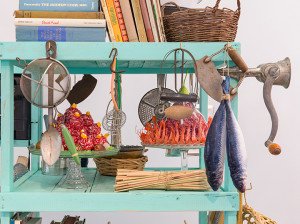New LES Art Exhibit Re-Examines ‘Nature’ in Human-Shaped World
By Savannah Cox, January 13, 2016
From hanging out in the Mets’ weight room to “invading” the backyards of South Park Sloperesidents, raccoons have been getting a lot of press lately.
Many consider the increased presence of these charcoal-eyed creatures to be an annoyance, but Washington Heights artist Dana Sherwood views them as signs of something else: the Anthropocene.
The term refers to the era that some scientists suggest we are living currently, in which human activity alters the planet. It’s the focus of Sherwood’s just-launched exhibition at the Lower East Side’s Denny Gallery.
In “Crossing the Wild Line,” which debuted on Jan. 10, Sherwood, 39, explores what she calls a new nature — one which, as the baseball-fan raccoons suggest, very much exists in urban spaces — and how people interact with it.
“It’s a very timely opening,” Sherwood said. “Every other week in the New York TimesI see a new piece about how invasive species are thriving in areas where there are large urban populations.”
The centerpiece of Sherwood’s exhibit is a food cart, which houses a video monitor that displays video footage from Sherwood’s time in Brazil.
“Basically I went down there, met with locals and did some research on animals found in that region,” Sherwood said. “I had this Brazilian cart filled with foods, made this elaborately designed platter and put it into part of a botanical garden that was part of the wilderness.”
Sherwood said she then left the food there for two weeks, where she had set up heat-sensor cameras to monitor how native species interacted with the cart’s offerings.
After the two-week waiting period ended, Sherwood returned to the cart, where she found that most of the food left had been consumed by native species.
More broadly, it signaled to her the “animal kingdom’s crossover” to a world where “everything has been influenced by man,” Sherwood said.
“Crossing the Wild Line” builds on years of work Sherwood has done on animal populations in urban spaces. Her interest in the Anthropocene era, however, is more recent.
“I think that through the practice of doing the work I saw these parallels, and discussions about the Anthropocene,” Sherwood said. “So I started to focus more on that.”
Sherwood says she sees evidence of the Anthropocene era in something as mundane as her exercise routine.
“I’ll go jogging in Washington Heights, and regularly see raccoons, skunks, porcupines and hawks,” Sherwood said. “You feel like you have to go out of the city for wildlife, but it’s teeming with it.”
That’s not an event without precedent, Sherwood says, nor is it one that we can just “brush under the rug.”
“We’re destroying nature; that’s a fact,” Sherwood said. “With the influx of animals losing their natural habitats, we’re cohabiting with them.”
Likewise, Sherwood thinks that the ways we’re responding to signs of the Anthropocene era — such as the rise of invasive species in urban and suburban areas — need work.
“People deal with these issues on a case-by-case basis,” Sherwood said. “We hire exterminators for live trapping, we take them out to the park, but the first thing they do is go to the nearest building … the solution needs to be over-arching.”
To Sherwood, the “solution” starts with reconsidering what we call the wilderness.
“The idea of a pristine wilderness doesn’t exist,” Sherwood said. “We need to come up with new ways of thinking about what nature is, and how to accept that things are irrevocably changed.”
What to do with the suburb-dwelling raccoons, then? Sherwood laughed. “Build a city for them.”
“Crossing the Wild Line” is on display at the Denny Gallery, 261 Broome St., until Feb. 21.



